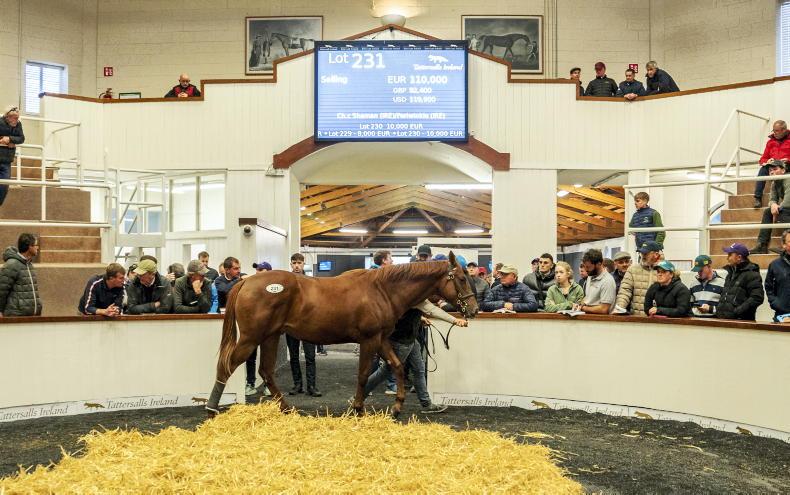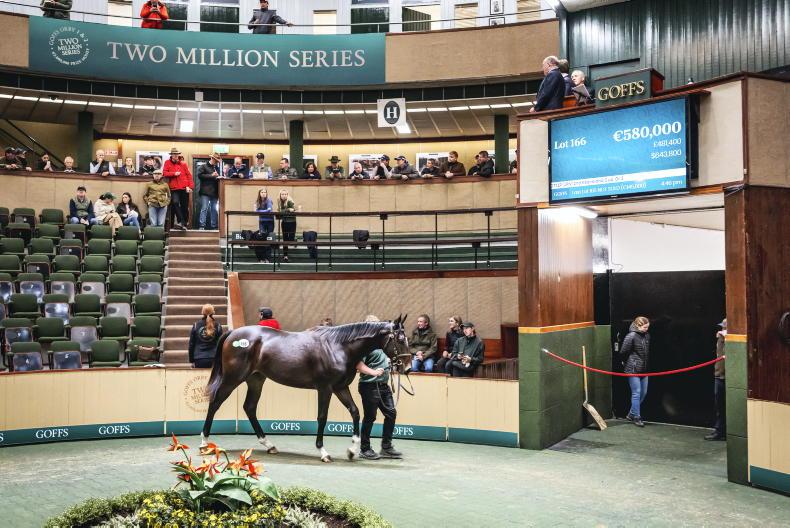EARLY in the yearling sales season, the general consensus was that trade was tricky. The market was selective, it was undergoing a correction - that was what consignors, sales companies and their statistics told us.
We looked across to Keeneland’s explosive trade with envy, and then boom! We got our own version at Tattersalls Book 1, where records tumbled and vendors rejoiced. The buyers - most notably Kia Joorabchian - appeared to be the driving force, and their spend continued into a record-breaking Book 2, seemingly helped by other buyers upping the ante in an attempt to fill their orders.
With the first foals of the year offered this week at Tattersalls Ireland, with Goffs and Tattersalls to follow over the next two weeks, it will be interesting to see how a mixed batch of yearling results will affect pinhookers’ spend.
So how did the pinhookers fare? I examined the results from Tattersalls Ireland September Yearling Sale, Goffs Orby Book 1, Tattersalls Book 1 and Tattersalls Book 2, to get an idea. I compared prices between lots sold as foals - that is, I removed any bought back or unsold as foals, and removed any withdrawn at the yearling sales.
To equate profit, I used a figure of €10,000 to cover costs between their purchase and sale. This, of course, can vary greatly between those prepping horses themselves, or using another consignor. Then there are unexpected costs for certain horses, so this round figure is the fairest method.
My findings are detailed in the table below. I’ve also included a table reminding us of the final statistics for each sale - for all lots, not just pinhooked lots.

Tough at lower end
Working in chronological order, it is perhaps unsurprising that pinhookers fared worst at Tattersalls Ireland, which has the lowest average of the four sales examined.
That’s not a criticism of the prices achieved, it’s just that this sale sells a lower-priced animal - indeed, the healthy clearance rate of 84% shows that vendors generally agreed with buyers’ valuation of their stock.
Perhaps the pinhooking returns at Tattersalls Ireland demonstrate the difficulty in making a profit on lower-priced horses, because they all cost the same to keep from foal to yearling, no matter their breeding or makeup. Or maybe pinhookers overpaid for that calibre of horse at the foal sales.
In my research, I also compiled lists of the top 10 pinhooking results, both by the difference between foal and yearling price, and on how the foal price multiplied. I looked at the latter, because the most interesting or impressive results, in my opinion, are when someone turns a €5,000 foal into a €50,000 yearling, rather than a €100,000 foal into a €200,000 yearling.
The greatest increase in value at the September Yearling Sale was Grangemore Stud’s Shaman colt out of Periwinkle. Bought as a foal for €16,000, he was knocked down to Alex Elliott for €110,000.

He was originally sourced at Goffs, as were eight of the top 10 in this category, one at Tattersalls, and the other bought at Arqana.
Looking at foals who multiplied in value there, top honours went to a King Of Change colt from Ladytown Stables, whose €3,000 foal price returned €30,000 from Peter and Ross Doyle. Next in the standings was an Advertise colt from Danesrath Stables, who cost the same as a foal at the Tattersalls Ireland Sapphire Sale, and resold for €24,000.
Again, eight of the top 10 in this table were sourced at Goffs and one at Tattersalls, the other originating from the aforementioned Sapphire Sale.
Profits increase at Goffs
Moving on to the Orby Sale, pinhookers fared much better, with 34% making a loss - less than half at the above-mentioned sale, and less than that at Book 2, which I found the most surprising fact from my research.
There was a common thread in the best pinhooking results, as Blue Point fillies sat first and third in the table of the greatest profits, and second and third by multiplying their foal price.
Ronan Griffin enjoyed the biggest return, as his €75,000 foal buy returned to Goffs to fetch €580,000, bought by Stroud Coleman. Offered by The Castlebridge Consignment on both occasions, the Blue Point filly benefited from a much-desired update, as her full-sister Raknah went from a rating of 76 to 93, via a listed win at Galway, during her time between sales.
Of those to make the largest profit, the top 10 were all sourced at Goffs as foals, and three of them were by Mehmas. When calculating how their foal price multiplied, the top 10 divided equally between Goffs and Tattersalls foal buys.
In the latter category, it was interesting to note that foals by Twilight Son - based at Annshoon Stud from 2025 - and Coulsty - who commands €5,500 at Rathasker Stud - appeared in the top 10.
The top spot went to another proven sire in Calyx, whose colt from Ballyvolane Stud was knocked down to Godolphin for €220,000, having cost €23,000 as a foal.

Book 1 notes
It should come as little or no surprise that pinhookers fared best at Tattersalls Book 1, where the average, median and turnover rose to record highs. What might surprise readers is that, of the top 10 pinhooks by profit, four were sourced at the Newmarket sale, five were bought at Goffs, and one was bought at Arqana.
Of those who multiplied in value, two of the top 10 were pinhooked at Tattersalls, seven at Goffs and one at Arqana. I think it might surprise people, as the Tattersalls December Foal Sale is generally considered to be where pinhookers invest most of their money, and Irish breeders shoulder transport costs in order to get a better price there.
Back to more predictable matters. Pinhookers reaped the rewards of investing in Blue Point, sire of four of the top 10 profit-makers, the best of which was a filly from Mountain View Stud.
Henry Lascelles paid 725,000gns for her last month, an increase of 560,000gns on the price paid by Barry Mahon and Michael Fitzpatrick’s Good Will Bloodstock last year, when she was sold by McCracken Farms, always a popular consignment.
Kudos, too, to Clifton Farm, who achieved the top three pinhook results, when considering how the foal price multiplied. 40,000gns might have been towards the bottom end at Book 1, but it was 20 times the price James Bloodstock for the Almanzor colt at Arqana, at €2,500.
Hugh Bleahen’s operation also sold a Sea The Stars colt for 510,000gns, having cost €50,000, while their Hello Youmzain colt went from €32,000 to 260,000gns, both sourced at Goffs.

Surprises at Book 2
Book 2 is a sale that breeders and pinhookers tend to aim at, as the average price is reliably high, and all the key players present. Trade this year was strong, the average and turnover reaching new highs, the median matching a previous record.
Considering those figures, it was surprising that 42% of pinhooked lots either made a loss, were bought back, or unsold.
Taking an impressive clearance rate of 91% into account, I presume that the vast majority of the sale’s vendors agreed with their stock’s valuation, leading me to believe that many pinhookers simply overpaid at the foal sales.
Of those who fared the best by profit achieved, four were pinhooked at Tattersalls and six at Goffs. Top honours went to Oaks Farm Stables and their Territories colt, sold for 750,000gns to Nurlan Bizakov’s Sumbe, owner/breeder of this year’s Prix Maurice de Gheest victor Lazzat (Territories).
This colt was bought by AP Bloodstock as a foal for 65,000gns, his price influenced by his full-brother Masseto, twice group-placed as a juvenile for Donnacha O’Brien. Pinhookers won’t have many more chances to get their hands on a Territories foal, as he has been sold to continue his career in India.
He is a loss, in my opinion, given that he has sired a Group/Grade 1 winner for the last four seasons - an achievement not many stallions can lay claim to.
Gleneagles was another sire of note regarding impressive returns, accounting for two of the top three pinhooks by how their foal price multiplied. John Foley’s Ballyvolane Stud took top honours, as they did at the Orby Sale, this time with a Gleneagles colt bought at Goffs for €28,000 and resold for 280,000gns.
Goffs Foal Sale accounted for six of the top 10 pinhooks by multiplying their value, the other four sourced at Tattersalls December Foal Sale.
